“A comfortable house is a great source of happiness. It ranks immediately after health and a good conscience.”
Sydney Smith, letter, Sept. 29, 1843
Archives for 2008
TT: Never on Sunday
 Mrs. T departed for Connecticut last Friday morning, and I promptly hurled myself into a frenzy of urban activity. It was a brilliant and balmy weekend in New York City, the best of all possible times to be out and about, and so I spent very little time at home. On Friday evening I saw To Be or Not to Be on Broadway. The next morning I went to the gym, dropped by Mr. JazzWax‘s apartment to listen to records, visited two art galleries, and returned to Broadway to see Katie Holmes make her stage debut in Arthur Miller’s All My Sons. On Sunday I took a brisk walk through Central Park, ending up at the Metropolitan Museum of Art, where I spent an hour looking at paintings, then returned to the Upper West Side to dine at Good Enough to Eat, where I hadn’t eaten for weeks. Walking through the front door felt a little like coming home after a sea voyage.
Mrs. T departed for Connecticut last Friday morning, and I promptly hurled myself into a frenzy of urban activity. It was a brilliant and balmy weekend in New York City, the best of all possible times to be out and about, and so I spent very little time at home. On Friday evening I saw To Be or Not to Be on Broadway. The next morning I went to the gym, dropped by Mr. JazzWax‘s apartment to listen to records, visited two art galleries, and returned to Broadway to see Katie Holmes make her stage debut in Arthur Miller’s All My Sons. On Sunday I took a brisk walk through Central Park, ending up at the Metropolitan Museum of Art, where I spent an hour looking at paintings, then returned to the Upper West Side to dine at Good Enough to Eat, where I hadn’t eaten for weeks. Walking through the front door felt a little like coming home after a sea voyage.
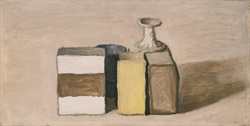 You’ve probably guessed that I spent a good-sized chunk of the weekend looking at the paintings, watercolors, and etchings of Giorgio Morandi, which are currently on display at the Met, Pace Master Prints, and Lucas Schoormans Gallery. My trip to the Met wasn’t quite as satisfying as I’d hoped, however, though not because of the show, which isn’t quite perfect–the choice of etchings is less than representative–but comes close enough to be unforgettable. The problem is that the curators of the show made the inexplicable and irreparable mistake of installing it in a high-traffic area that is mere steps away from the museum’s new downstairs cafeteria. As a result, “Giorgio Morandi, 1890-1964” is drawing large numbers of people who would rather talk than look at art, not a few of whom seem unaware that the use of a cellphone within five hundred yards of a Morandi still life would be punishable by death and/or dismemberment if I had anything to do with it.
You’ve probably guessed that I spent a good-sized chunk of the weekend looking at the paintings, watercolors, and etchings of Giorgio Morandi, which are currently on display at the Met, Pace Master Prints, and Lucas Schoormans Gallery. My trip to the Met wasn’t quite as satisfying as I’d hoped, however, though not because of the show, which isn’t quite perfect–the choice of etchings is less than representative–but comes close enough to be unforgettable. The problem is that the curators of the show made the inexplicable and irreparable mistake of installing it in a high-traffic area that is mere steps away from the museum’s new downstairs cafeteria. As a result, “Giorgio Morandi, 1890-1964” is drawing large numbers of people who would rather talk than look at art, not a few of whom seem unaware that the use of a cellphone within five hundred yards of a Morandi still life would be punishable by death and/or dismemberment if I had anything to do with it.
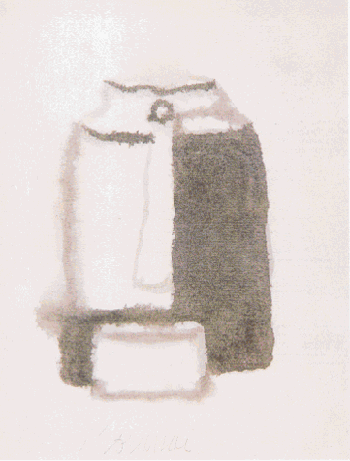 I’m sure, by the way, that I beamed benevolently at some of the very same people when I saw them in Central Park a few minutes earlier. Parks are supposed to be crowded on balmy Sunday afternoons, and I enjoyed every minute of my long walk from the West Side to the East Side. But a park is by definition open to all comers, a gathering place for the demos. An art museum is a trickier proposition. I know that I ought to want the Metropolitan Museum to be crowded seven days a week, that it should be a sign of cultural health for its galleries to be packed. I also know what it’s like to visit a museum that time and demography have passed by. In 2003 I paid a weekday visit to the Newark Museum and was shocked to find myself the only person in the galleries other than the guards. I would never want that to happen to the Met.
I’m sure, by the way, that I beamed benevolently at some of the very same people when I saw them in Central Park a few minutes earlier. Parks are supposed to be crowded on balmy Sunday afternoons, and I enjoyed every minute of my long walk from the West Side to the East Side. But a park is by definition open to all comers, a gathering place for the demos. An art museum is a trickier proposition. I know that I ought to want the Metropolitan Museum to be crowded seven days a week, that it should be a sign of cultural health for its galleries to be packed. I also know what it’s like to visit a museum that time and demography have passed by. In 2003 I paid a weekday visit to the Newark Museum and was shocked to find myself the only person in the galleries other than the guards. I would never want that to happen to the Met.
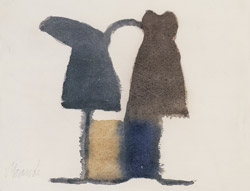 Alas, the experience of high art is democratic only in theory, never in practice, which is why there is something inherently contradictory, perhaps even deeply wrong, about seeing crowds at an exhibition of the paintings of Giorgio Morandi. Morandi is a difficult painter, one whose still lifes inevitably strike the casual viewer as both repetitive and plain. They require close, quiet attention in order to be appreciated. Giorgio Morandi: The Art of Silence is the apt title of a monograph about Morandi published a couple of years ago. It is inconceivable that anyone capable of talking in the presence of Morandi’s late watercolors, which are so concentrated and oblique as to border on outright abstraction, could possibly be appreciating them.
Alas, the experience of high art is democratic only in theory, never in practice, which is why there is something inherently contradictory, perhaps even deeply wrong, about seeing crowds at an exhibition of the paintings of Giorgio Morandi. Morandi is a difficult painter, one whose still lifes inevitably strike the casual viewer as both repetitive and plain. They require close, quiet attention in order to be appreciated. Giorgio Morandi: The Art of Silence is the apt title of a monograph about Morandi published a couple of years ago. It is inconceivable that anyone capable of talking in the presence of Morandi’s late watercolors, which are so concentrated and oblique as to border on outright abstraction, could possibly be appreciating them.
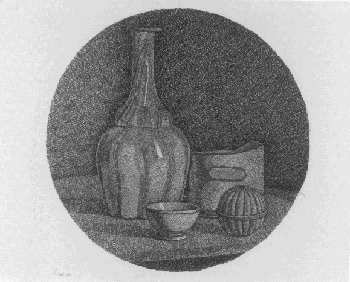 My Saturday visits to Pace Master Prints and Lucas Schoormans Gallery were a different story. I spent a half-hour looking at the two dozen etchings on display at Pace Master Prints, and throughout that time I was the only person in the gallery devoted to Morandi. I was glad to be alone–but troubled, too, by the fact that no one else in New York City was there. Morandi, after all, was one of the greatest printmakers of the twentieth century, a master of his infinitely subtle medium, and the Pace show is a once-in-a-lifetime experience, an indispensable pendant to the Met retrospective. How is it possible that so important an exhibition should have drawn only a single viewer at midday on a Saturday in October? Be careful what you ask for, I thought as I left the gallery.
My Saturday visits to Pace Master Prints and Lucas Schoormans Gallery were a different story. I spent a half-hour looking at the two dozen etchings on display at Pace Master Prints, and throughout that time I was the only person in the gallery devoted to Morandi. I was glad to be alone–but troubled, too, by the fact that no one else in New York City was there. Morandi, after all, was one of the greatest printmakers of the twentieth century, a master of his infinitely subtle medium, and the Pace show is a once-in-a-lifetime experience, an indispensable pendant to the Met retrospective. How is it possible that so important an exhibition should have drawn only a single viewer at midday on a Saturday in October? Be careful what you ask for, I thought as I left the gallery.
Things were different in yet another, more benign way when I arrived at Lucas Schoormans Gallery, whose Morandi show seems to me to be just about perfect. Instead of a hundred paintings and works on paper, there were a couple of dozen carefully chosen pieces on display. Instead of a clamorous horde of visitors–or none–there were six or seven people whose rapt, uncasual silence spoke for itself. Not for a moment did I doubt that they were there for the right reasons. Yet they had passed no test to be admitted: Lucas Schoormans Gallery, like Central Park, is open to all comers, not just to wealthy collectors or accredited connoisseurs. To partake of its offerings is, in the truest and best sense of the word, a democratic experience.
As for the Met, it is…well, the Met. While no great museum gets everything right, the Metropolitan Museum of Art, like the Phillips Collection, comes far closer than most. I am blessed to be within comfortable walking distance of its front door, and I expect to go back to see its Morandi exhibition several more times–but never again on a Sunday afternoon. It is possible to believe in the necessity of democracy without feeling the need to idealize it.
* * *
Lucas Schoormans Gallery’s “Giorgio Morandi: Paintings and Works on Paper” and Pace Master Prints’ “The Etchings of Giorgio Morandi” both close on Saturday. For more information, go here and here.
“Giorgio Morandi, 1890-1964” is up at the Met through December 14.
TT: Snapshot
Excerpts from the 1997 premiere of Paul Taylor’s Piazzolla Caldera, performed by the Paul Taylor Dance Company:
(This is the latest in a weekly series of arts-related videos that appear in this space each Wednesday.)
TT: Almanac
“Great music is that which penetrates the ear with facility and leaves the memory with difficulty. Magical music never leaves the memory.”
Sir Thomas Beecham (quoted in the Sunday Times of London, Sept. 16, 1962)
TT: The horror! The horror!
If you’re a biographer, you’ll appreciate this: I spent most of Monday making sure that the manuscript of A Cluster of Sunlight: The Life of Louis Armstrong conforms to fair-use requirements for quotations from copyrighted sources. I ended up chopping some three thousand-odd words out of what I’d thought was the final draft, which (octuple arrgh) made the book better.
Alas, my eyes are now red and gritty from excessive busywork, and I don’t have it in me to finish the post I started writing about my recent art-related adventures, so you’ll have to do without it until tomorrow. In lieu of a nice juicy posting, kindly note that I posted all sorts of new stuff in the right-hand column over the weekend. But you already noticed that, right? No? Well, get cracking.
TT: The kind of mail you like to open
From a regular reader of “About Last Night”:
Best wishes on your anniversary. May you have many more and may they all be as happy as this one. It has now been five years that your blog has been an almost daily part of my life. For that I thank you deeply. It has enriched my life in ways that you cannot even imagine.
What can I say? The pleasure is all ours.
TT: Almanac
“A portrait is a painting where there’s always something not quite right about the mouth.”
John Singer Sargent, quoted by Max Beerbohm in S.N. Behrman, Portrait of Max (courtesy of John Pancake)
TT: Repose of the soul
“To me wherever you go–even behind the Iron Curtain–it’s just another city,” Louis Armstrong told a reporter in 1966. “All hotels are alike–bed, bureau, two pillows.” I know what he meant, and now that I spend so much time on the road reviewing regional theater for The Wall Street Journal, I escape the terrible sameness of hotel life by staying in bed-and-breakfast inns as often as I can. I love the unassuming comfort that these homes-away-from-home afford, but the gingham-and-frills décor favored by most innkeepers isn’t my style–I’m a confirmed midcentury modernist–and from time to time I feel the need to do something completely different.
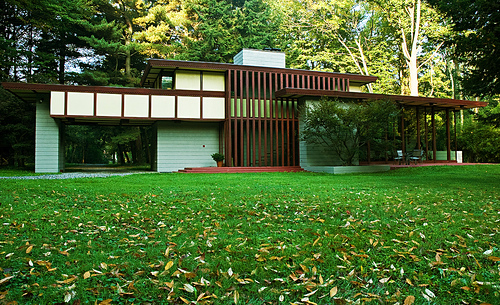 Usually that means holing up for a night or two in an ultra-modern big-city high-rise hotel, and under normal circumstances that’s what I would have done when I went to Cleveland last week to visit the Great Lakes Theater Festival and the Cleveland Play House. It happened, though, that the only performances of the Great Lakes Theater Festival’s productions of Macbeth and Into the Woods that I could stuff into my schedule took place last Sunday and Wednesday, meaning that I’d have to spend four nights in town instead of my usual two. So instead of staying in the theater district of Cleveland, Mrs. T and I spent the better part of a week at the Penfield House, a half-century-old home designed by Frank Lloyd Wright, and turned a business trip into a retreat.
Usually that means holing up for a night or two in an ultra-modern big-city high-rise hotel, and under normal circumstances that’s what I would have done when I went to Cleveland last week to visit the Great Lakes Theater Festival and the Cleveland Play House. It happened, though, that the only performances of the Great Lakes Theater Festival’s productions of Macbeth and Into the Woods that I could stuff into my schedule took place last Sunday and Wednesday, meaning that I’d have to spend four nights in town instead of my usual two. So instead of staying in the theater district of Cleveland, Mrs. T and I spent the better part of a week at the Penfield House, a half-century-old home designed by Frank Lloyd Wright, and turned a business trip into a retreat.
The Penfield House is one of six Wright-designed houses that can be rented on a short-term basis. It’s located in Willoughby, a quiet suburb east of downtown Cleveland. The house isn’t visible from the road–it’s in the middle of thirty acres of heavily wooded land–and you have to look closely to spot the Cherokee-red gate which tells you that you’ve gotten where you’re going. You push open the gate and drive down the gravel road, and all at once the house comes quietly into view, a simple two-story home built out of glass, wooden beams, concrete blocks, and light tan asbestos-and-concrete panels.
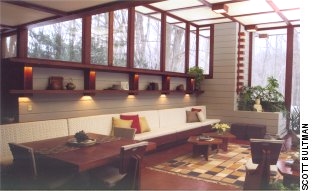 Like all of Wright’s Usonian houses, the Penfield House seems to melt into the landscape rather than dominating it. As you pass through the unostentatious entrance, you feel as though you’re still out of doors, for one of the walls of the twelve-foot-high living room is made almost entirely of glass, and the ceiling and floor extend beyond the glass wall in such a way as to create the illusion that the house is wide open to the surrounding woodland. The Chagrin River is nearby, and Paul Penfield, the owner, has cut a trail through the woods, making it possible for guests to wander at their leisure. Even though the house is only twenty minutes from downtown Cleveland, the city feels as though it’s on the far side of the world. One afternoon I sat in the living room watching the leaves fall, and a half-dozen deer sauntered through the yard as though I didn’t exist.
Like all of Wright’s Usonian houses, the Penfield House seems to melt into the landscape rather than dominating it. As you pass through the unostentatious entrance, you feel as though you’re still out of doors, for one of the walls of the twelve-foot-high living room is made almost entirely of glass, and the ceiling and floor extend beyond the glass wall in such a way as to create the illusion that the house is wide open to the surrounding woodland. The Chagrin River is nearby, and Paul Penfield, the owner, has cut a trail through the woods, making it possible for guests to wander at their leisure. Even though the house is only twenty minutes from downtown Cleveland, the city feels as though it’s on the far side of the world. One afternoon I sat in the living room watching the leaves fall, and a half-dozen deer sauntered through the yard as though I didn’t exist.
The sense of removal from the encroaching world is heightened by the fact that you can’t surf the Web in the Penfield House. During my stay there, I checked my e-mail once a day by driving a mile to the parking lot of a Wendy’s that had free wireless service. Otherwise I was out of touch, and glad to be. Instead of keeping up with current events, I read two new books from cover to cover, Brad Gooch’s forthcoming biography of Flannery O’Connor and John Lucas’ Thomas Beecham: An Obsession With Music, and listened to Stravinsky’s Apollo and Symphonies of Wind Instruments, the Copland Piano Sonata, Julian Bream’s recording of Lennox Berkeley’s Guitar Sonatina, and a Beethoven string quartet. The house has a TV, but we never bothered to turn it on.
At night we drove into the city to dine and see shows, but we came back to the house as soon as we were done, for we knew within minutes of our arrival on Sunday that we’d want to spend as much time there as possible. Since both theaters were dark on Monday, Mrs. T and I spent the whole day and night at the house, leaving only long enough to buy groceries. After dinner we turned on all the lights, went outside, and marveled at its warm, unassuming beauty. Even though the Penfield House is a work of art in and of itself, Paul and his wife Donna have gone to considerable trouble to make it look and feel like a home, not a museum. I’ve never stayed in a more comfortable place, or a more soothing one.
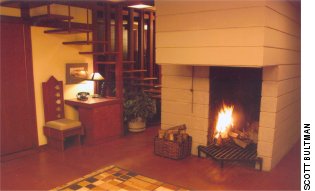 Some part of this comfort, I know, arose less from the house than from the circumstances of our staying there. To spend four days in a Web-free woodland retreat could scarcely fail to please an Upper West Side writer who lives in the middle of the hum and buzz of urban culture. But it wouldn’t have been the same had we stayed in a log cabin or a McMansion, for the all-pervading orderliness of the grid that Wright used to generate the floor plan and architectural detail of the Penfield House is both relaxing and reassuring to the eye. Modern the house most definitely is, but not in the hectoring manner of the International Style. It is, above all, tranquil, a point of repose in a world of pandemonium, a place where you can hear yourself think–or, if you like, where you can think of nothing at all. Wallace Stevens wrote a poem called “Not Ideas About the Thing but the Thing Itself.” Such self-sufficient things were the stuff of which our four days at Penfield House were made: falling leaves, train whistles in the distance, deer on the lawn, rain on the roof.
Some part of this comfort, I know, arose less from the house than from the circumstances of our staying there. To spend four days in a Web-free woodland retreat could scarcely fail to please an Upper West Side writer who lives in the middle of the hum and buzz of urban culture. But it wouldn’t have been the same had we stayed in a log cabin or a McMansion, for the all-pervading orderliness of the grid that Wright used to generate the floor plan and architectural detail of the Penfield House is both relaxing and reassuring to the eye. Modern the house most definitely is, but not in the hectoring manner of the International Style. It is, above all, tranquil, a point of repose in a world of pandemonium, a place where you can hear yourself think–or, if you like, where you can think of nothing at all. Wallace Stevens wrote a poem called “Not Ideas About the Thing but the Thing Itself.” Such self-sufficient things were the stuff of which our four days at Penfield House were made: falling leaves, train whistles in the distance, deer on the lawn, rain on the roof.
On Tuesday morning I rose early, went downstairs, and wrote a drama column for The Wall Street Journal. I sat at the kitchen table, listening to the birds singing outside the house, and thought to myself, I could write a book here. The piece came easily, and by noon I’d driven to Wendy’s, e-mailed it to New York, and returned home–for by then Hilary and I both thought of the Penfield House as our home. That day was the first anniversary of our marriage, and we celebrated in style, eating a flawlessly served champagne dinner at Stages, the onsite bistro of the Cleveland Play House, then strolling down the hall to see Michael Frayn’s Noises Off, the funniest play ever written. I’d added it to my schedule partly because I’d never seen the company and partly because Mrs. T had never seen the play. You couldn’t have asked for a more festive evening. Still, the best part was when we drove back to the Penfield House, unlocked the gate, and put the world behind us again.
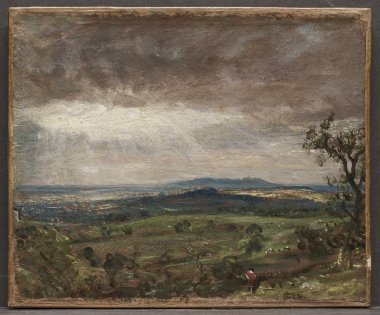 We left on Thursday morning with the utmost reluctance, easing the pain of our going by paying a visit to the Cleveland Museum of Art en route to the airport. It is, to be sure, a very great museum, just as our life in New York and Connecticut is an unmixed blessing, and we rejoiced in seeing such masterpieces as John Constable’s “Hampstead Heath, Looking Toward Harrow,” an exquisite little oil on paper that I longed to show off to Our Girl, who is responsible for having gotten me excited about Constable in the first place. Yet all that Mrs. T and I could talk about on the flight home was how much we looked forward to our next trip to Cleveland. May it come soon.
We left on Thursday morning with the utmost reluctance, easing the pain of our going by paying a visit to the Cleveland Museum of Art en route to the airport. It is, to be sure, a very great museum, just as our life in New York and Connecticut is an unmixed blessing, and we rejoiced in seeing such masterpieces as John Constable’s “Hampstead Heath, Looking Toward Harrow,” an exquisite little oil on paper that I longed to show off to Our Girl, who is responsible for having gotten me excited about Constable in the first place. Yet all that Mrs. T and I could talk about on the flight home was how much we looked forward to our next trip to Cleveland. May it come soon.
